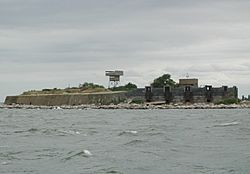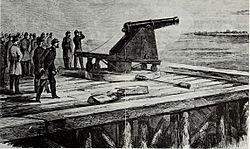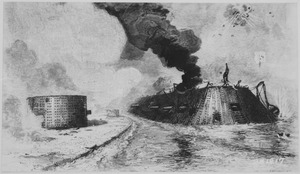Fort Wool facts for kids
Quick facts for kids Fort Wool |
|
|---|---|
| Part of Harbor Defenses of Chesapeake Bay 1905–1945 | |
| Rip Raps island between Willoughby Spit and Old Point Comfort, Virginia | |

Fort Wool Island from the Miss Hampton boat cruise
|
|
| Type | Sea fort |
| Site information | |
| Owner |
|
| Controlled by |
|
| Open to the public |
No |
|
Fort Wool
|
|
| Location | Rip Raps island between Willoughby Spit and Old Point Comfort, Hampton, Virginia |
| Area | 15 acres (6.1 ha) |
| Built | 1819 |
| Architect | Simon Bernard |
| NRHP reference No. | 69000339 |
| Significant dates | |
| Added to NRHP | November 25, 1969 |
| Site history | |
| Built | 1818–1861 |
| Built by | United States Army Corps of Engineers |
| In use | 1861–present |
| Materials | Stone |
| Battles/wars | American Civil War World War I World War II |
Fort Wool is an old island fort (a strong building for defense) located at the entrance of Hampton Roads in Virginia. It's right next to the Hampton Roads Bridge-Tunnel (HRBT). Today, this island is officially called Rip Raps Island. The fort is about 7 feet above the water and is close to Old Point Comfort and Fort Monroe.
The fort was first named Castle Calhoun or Fort Calhoun after John C. Calhoun, who was the Secretary of War. But during the American Civil War on March 18, 1862, its name was changed to Fort Wool. This new name honored Maj. Gen. John Ellis Wool. You might still see it called "Rip Raps" on maps, which was also a name used during the Civil War.
Fort Wool was one of over forty forts built after the War of 1812. This was when British forces sailed into the Chesapeake Bay and even burned the U.S. capital. These new forts were part of a big plan to protect America's coasts. The fort was designed by Simon Bernard, a French engineer who used to work for Napoleon. Fort Wool was built on a pile of stones that ships used to dump when they entered Hampton's harbor. It was meant to have many levels of casemates (rooms with openings for guns) and a top level for cannons. It was planned to hold 216 cannons, but it was never fully finished. Only about two-thirds of the first two levels were built. Fort Wool's main job was to work with Fort Monroe, which was right across the channel, to protect the harbor entrance with a crossfire.
Around 1902, most of the original fort was taken down, except for eight casemates on the west side. New defenses were built. These new defenses included three batteries, each with two 6-inch (152 mm) guns, and two more batteries with a total of six 3-inch (76 mm) guns. These guns stayed in place for many years, with some changes. By 1942, only the six original 3-inch guns were left. Two of these were sent to Fort John Custis nearby. During World War II, a new battery for two long-range 6-inch guns was built over one of the old batteries, but the guns were never actually put there. The military stopped using the fort in 1953.
Contents
Building Fort Wool: A History of Its Construction
Designing the Fort
Simon Bernard, a French engineer, was asked by Secretary of War John C. Calhoun to design or improve forts to protect important U.S. ports. Bernard planned over forty new forts, including Fort Wool, which he first called Fort Calhoun. The fort was meant to be huge, with four levels of gun rooms (casemates) and a top level for cannons. It was designed to hold 216 cannons and a thousand soldiers. It was planned as the first "tower fort" of its kind, similar to Castle Williams in New York.
The fort was designed in a shallow "V" shape, pointing north, with rounded ends. It was to be built on a 15-acre artificial island southeast of Old Point Comfort in Hampton, Virginia. Construction started in 1819. Workers began dumping granite boulders into the water. It took four years just to build the rock pile up to the planned 6-foot-tall island. It took three more years before the foundation was ready for the fort itself to be built.
Challenges During Construction
Building Fort Wool faced many problems. One big issue was that the island kept sinking under the weight of the fort. This is called subsidence. Even a young Robert E. Lee, who later became a famous general, worked on the fort as an engineer. It was his first independent command. He tried to stabilize the island by bringing in more stone, but the fort never reached its planned size. Lee realized the stone foundation couldn't support the weight of a four-level fort.
Work on the fort finally began in 1826. But because the island kept sinking, only two-thirds of the first level of gun rooms were finished by 1830. Construction continued until 1834, but only half of the second level was completed. The island continued to settle, causing many delays. The outbreak of the American Civil War in 1861 completely stopped construction. At that point, the fort had one complete level and one open-top level of gun rooms around about two-thirds of its planned shape. The back of the fort, facing south, was left open.
Presidential Connections
Fort Wool has a surprising connection to several U.S. presidents. President Andrew Jackson, who was heartbroken after his wife's death and not in good health, often visited Fort Wool in the late 1820s and 1830s. He even called it his "White House." Jackson built a small hut there and would watch ships pass by. He even made important decisions with his advisors from the fort.
Later, in the mid-1840s, President John Tyler found peace on the island after his first wife died. Abraham Lincoln also visited the fort during his time.
Even famous entertainers have a link to Fort Wool. The actor Sir Alec Guinness was stuck in a minefield near the fort during World War II. The comedian Red Skelton also visited Fort Wool during the war to entertain the soldiers.
Fort Wool During the Civil War
The fort was first named after John C. Calhoun, who was a Southern politician. But in 1862, it was renamed after Maj. Gen. John Ellis Wool, a hero from the Mexican War and the commander at Fort Monroe. During the Civil War, Fort Wool was armed with 10 guns. It fired at Confederate positions and ships.

An experimental long-range cannon, called the Sawyer gun, was placed at Fort Calhoun in mid-1861 during the Civil War. This gun had a special barrel that made the cannonball spin, helping it fly further and more accurately. It could reach Sewell's Point, which was more than three miles away, where the Confederates had a fort. The Sawyer gun also fired at the Confederate ironclad ship, the CSS Virginia, during the Battle of the Ironclads in 1862. However, it didn't damage the ironclad's strong armor.
Modernizing Fort Wool: Endicott Batteries
In 1885, a group called the Endicott Board suggested ways to improve America's coastal defenses. At Fort Wool, this meant tearing down most of the old fort, except for a small part on the west side. This made space for new, modern gun positions.
After 1902, five new gun batteries were built at the fort. Fort Wool was given smaller, faster-firing guns because Fort Monroe already had many large cannons. The 3-inch guns at Fort Wool were meant to protect underwater minefields from enemy ships that might try to clear them. Some of these mines were even stored at Fort Wool, but they were controlled from Fort Monroe.
Here are some of the batteries built at Fort Wool:
- Battery Ferdinand Claiborne: two 6-inch guns on special disappearing carriages (used from 1908-1918). These carriages would hide the gun after it fired.
- Battery Alexander Dyer: two 6-inch guns on disappearing carriages (used from 1908-1917).
- Battery Horatio Gates: two 6-inch guns on disappearing carriages (used from 1908-1942).
- Battery Henry Lee: four 3-inch rapid-fire guns (used from 1905-1943).
- Battery Jacob Hindman: two 3-inch rapid-fire guns (used from 1905-1946).
Fort Wool in the World Wars
World War I Role
During World War I, in 1917 and 1918, most of the 6-inch guns at Fort Wool were removed. They were sent to be used as field guns on the Western Front in Europe. Only two 6-inch guns remained, which were moved to Battery Gates.
- Battery Horatio Gates: two 6-inch guns on disappearing carriages (used from 1908-1942).
- Battery Henry Lee: four 3-inch rapid-fire guns (used from 1905-1943).
- Battery Jacob Hindman: two 3-inch rapid-fire guns (used from 1905-1946).
- During both World War I and World War II, special anti-submarine nets were stretched across the harbor between Fort Wool and Fort Monroe to stop enemy submarines.
World War II Role
A new battery, Battery 229, was built on top of the old Battery Horatio Gates from March 1943 to January 1944. This battery was designed for two 6-inch guns with shields and long-range carriages. The construction was finished, and the carriages were installed, but the actual gun barrels were never put in place. A radar system was also installed in 1943 to help control the firing of Battery 229. The older 6-inch guns were scrapped in 1942–43. The four 3-inch guns from Battery Lee were moved to Fort Story in 1942 and 1943.
In 1946, the two 3-inch guns from Battery Hindman were moved to Fort Monroe to be used for saluting ceremonies.
Fort Wool Today
Fort Wool was no longer needed by the military after 1953. It was then given to the Commonwealth of Virginia. In the 1950s, the Hampton Roads Bridge-Tunnel (HRBT) was built right next to Fort Wool. The southern island of the HRBT was connected to the fort by a raised path made of earth. The HRBT opened in 1957.
In 1967 and again in 1970, the City of Hampton turned the fort into a park. People could visit it by taking the passenger ferry called Miss Hampton II. You can also see the fort if you are driving west towards the HRBT southern tunnel on Interstate 64.
The island, now called Rip Raps, continues to settle over time. Because of this, sometimes parts of the original fort's gun rooms are closed for safety reasons.
On April 28, 2007, a large garrison flag was raised over Fort Wool for the first time. This happened during a parade of tall ships sailing past the fort, celebrating the 400th anniversary of the settlement of Jamestown.
In 2020, Fort Wool was changed into a bird sanctuary. This means that regular public visits to the fort were stopped to protect the birds.





